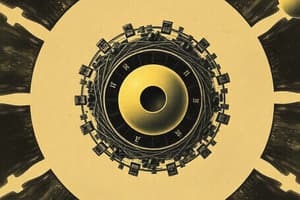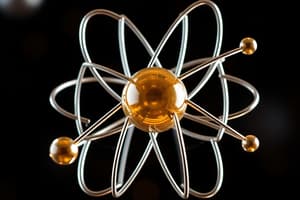Podcast
Questions and Answers
What was the prevailing model of the atom before Rutherford's experiment?
What was the prevailing model of the atom before Rutherford's experiment?
- A dense, solid sphere.
- A miniature solar system with electrons orbiting a nucleus.
- A diffuse cloud of positive charge with embedded electrons. (correct)
- A nucleus surrounded by a cloud of neutrons.
What unexpected observation in Rutherford's gold foil experiment led to the concept of the nucleus?
What unexpected observation in Rutherford's gold foil experiment led to the concept of the nucleus?
- The gold foil became radioactive.
- Some alpha particles were deflected at large angles. (correct)
- Most alpha particles passed straight through the gold foil.
- The alpha particles transformed into electrons.
How did Rutherford's model of the atom differ from Thomson's model?
How did Rutherford's model of the atom differ from Thomson's model?
- Rutherford's model described electrons embedded in a positive cloud, while Thomson's did not.
- Rutherford's model proposed a dense, solid atom, while Thomson's did not.
- Rutherford's model included neutrons, while Thomson's did not.
- Rutherford's model introduced the concept of a nucleus, while Thomson's did not. (correct)
What analogy did Rutherford use to describe his model of the atom?
What analogy did Rutherford use to describe his model of the atom?
What issue with Rutherford's model did Niels Bohr address?
What issue with Rutherford's model did Niels Bohr address?
What experimental evidence led Rutherford to infer the importance of the nucleus as a fundamental building block?
What experimental evidence led Rutherford to infer the importance of the nucleus as a fundamental building block?
What did Rutherford name the positively charged particle in the hydrogen nucleus?
What did Rutherford name the positively charged particle in the hydrogen nucleus?
Who discovered the neutron?
Who discovered the neutron?
Which element is named in honor of Ernest Rutherford?
Which element is named in honor of Ernest Rutherford?
What was Rutherford's position at the University of Manchester?
What was Rutherford's position at the University of Manchester?
Flashcards
Rutherford's Experiment
Rutherford's Experiment
An experiment where alpha particles were fired at gold foil, revealing atomic structure.
Nucleus
Nucleus
The tiny positively charged center of an atom, containing most of its mass.
Plum Pudding Model
Plum Pudding Model
An early atomic model proposing electrons are embedded in a positive charge cloud.
Electrons
Electrons
Signup and view all the flashcards
Alpha Particles
Alpha Particles
Signup and view all the flashcards
Solar System Model
Solar System Model
Signup and view all the flashcards
Proton
Proton
Signup and view all the flashcards
Neutron
Neutron
Signup and view all the flashcards
Rutherfordium
Rutherfordium
Signup and view all the flashcards
Bohr's Model
Bohr's Model
Signup and view all the flashcards
Study Notes
Rutherford's Atomic Model
- Rutherford's experiment involved firing positively charged particles at a thin layer of atoms.
- Most particles passed straight through, some were deflected, and some bounced back.
- This suggested the atom consisted mostly of empty space with a small, dense, positively charged center (nucleus).
- Electrons orbited the nucleus.
Inside the Atom
- In 1907, Rutherford became a physics professor at the University of Manchester.
- He made a significant discovery about the atom's structure.
- The previously accepted model (the plum pudding model) depicted an atom as a diffuse cloud of positive charge, with electrons embedded.
- Rutherford's experiment disproved the plum pudding model.
Radical Shift
- In 1911, Rutherford proposed a new atomic model.
- The model was a miniature solar system: mostly empty space, with electrons orbiting a tiny nucleus held together by energy.
- This new model was a significant advancement in understanding atomic structure.
Atomic Nucleus and the Proton
- Rutherford's work with nitrogen and alpha particles led him to discover that the hydrogen nucleus, having a positive charge, is a fundamental building block of all matter.
- He named this fundamental building block "the proton".
- It was realized that atoms also contain other particles inside the nucleus with a neutral charge. These particles were later identified (1932) as the neutron.
Studying That Suits You
Use AI to generate personalized quizzes and flashcards to suit your learning preferences.




